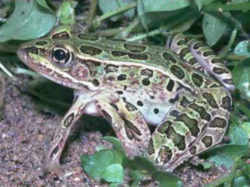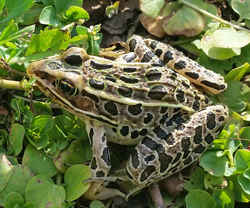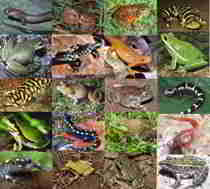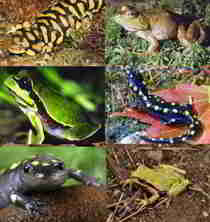
Vermont Symbols
Vermont State Amphibian
Northern Leopard Frog

(Rana pipiens)
Adopted on April 21, 1998.
Senate Bill No. 241 was introduced on January 6, 1998, designating the Northern Leopard Frog (Rana pipiens) the official state amphibian of Vermont was approved by the Senate and by the House of Representatives. Governor Howard Dean signed the legislation on April 21, 1998 with an effective date of July 1, 1998.
"A healthy northern leopard frog population is desirable in Vermont, and is threatened by loss of habitat and deformities that may be related to changes in the environment. Environmental problems that affect frogs could be a warning about further impacts upon other species, including humans. The colors of the northern leopard frog represent the beauty of our state during all seasons. Ponds are an attractive part of Vermont's landscape and the northern leopard frog helps control the number of insects and pests in our state's ponds. It also helps keep Vermont's pristine wetlands clean by eating algae. For all of these reasons, the general assembly finds it appropriate to designate the northern leopard frog as the state amphibian."
Vermont State Amphibian: Northern Leopard Frog

The Northern Leopard Frog is a wide ranging and abundant species. It is also one of the more cold tolerant anuran species in Northe America, though it is not known to be freeze tolerant and thus requires a freeze free hibernation site. It is a medium sized frog reaching sizes of 3 1/2 inches in length. It receives its name from its dark spots which are usually circular in shape and irregularly placed throughout the body. The background color can be green, brown or both. There are also two light colored dorsolateral folds, lines of raised glandular skin in an area between the back and the sides.
Common Names
Also called the Meadow or Grass Frog
Location
This frog is found throughout most of northern North America except on the West coast. Its distribution is seemingly centered along the US/Canada border.
Habitat
Leopard frogs easily adapt to new surroundings. They are found from deserts to mountain meadows, from freshwater areas with abundant vegetation to marshes and moist fields.
Adult Northern Leopard Frogs are semi-terrestrial and maintain home ranges of up to 600 square meters during the summer. The size of the range is related to the size of the frog. Within the home range, Northern Leopard Frogs spend much of their time in small clearings of damp soil, called forms, or in crevices if the habitat is forested. They favour open, grassy sites, which has given them one of their common names, the Meadow Frog.
Breeding ponds in other parts of their range are usually under 60 m in diameter, and approximately 2 metres deep at their deepest point. In British Columbia, eggs are laid in 15 to 65 cm of water. Breeding ponds are warmer and shallower than the streams and ponds used for hibernation, and usually have rich vegetation.
Northern Leopard Frogs hibernate from October through to March, in deep ponds or streams in small indentations in the mud. These water bodies must have adequate oxygen, and not freeze solid in winter.
Reproduction
Adult Northern Leopard Frogs gather at breeding ponds very early in the spring - sometimes before the last frost - when the water temperature approaches 10°C. Males migrate to the breeding ponds from their hibernacula and begin calling. Females follow some five to seven days later. Calling males typically float at the water's surface in the warmest part of the pond, and are far more visible than the females clustered along the pond's shoreline. Mating takes place between late April and early June, over a period of two to seven days. Each female mates once, lays a single egg mass, and leaves the pond; males probably mate more than once.
Egg masses are concentrated in warm, shallow water; they may float at the water's surface or be attached to submerged vegetation. Each egg mass contains between 1000 and 5000 eggs. Hatchlings emerge in about nine days and spend a couple of days clinging to vegetation and the remnants of the egg mass before becoming free-swimming tadpoles.
Tadpoles transform in summer (late July), emerging as miniature frogs (metamorphs) about 3.5 cm long. Mortality among these juveniles is very high; for a short time they make up a huge proportion of the population (up to 98 percent), but they are very quickly decimated by predation. Those metamorphs that survive to reach sexual maturity do so in about two years, though maturity is dependent more on size (and hence food availability) than age. Northern Leopard Frogs become mature at 5 to 6 cm in length.
Northern Leopard Frogs have a lifespan of about four years in the wild, and have been known to live nine years in captivity.
Diet
Northern Leopard Frogs are indiscriminate predators as adults; they will eat virtually anything that moves. They use a sit-and-wait strategy, waiting for the prospective meal to come fairly close before they orient toward it, stalk, then leap 15-40 cm to seize the prey. The diet consists primarily of insects - beetles, ants, flies, and leafhoppers. Other invertebrate prey includes pillbugs, worms, snails and slugs. Adults often eat smaller frogs, including juveniles of their own species. Northern Leopard Frogs may occasionally consume other vertebrates; voles, birds, and even garter snakes have been found in the stomachs of large frogs. Both nocturnal (active by night) and diurnal (active by day) prey species have been found in the stomach contents, indicating that Northern Leopard Frogs hunt during both periods.
Tadpoles are mostly herbivorous, grazing on algae.
Northern Leopard Frogs are themselves on the menu for a variety of predators, including herons, grebes, mergansers, several snake species, turtles,
fish and larger frogs. Humans have used these frogs as a food item as well. Tadpoles are consumed by aquatic insect larvae, water birds, garter snakes,
fish and leeches.
Vermont Statutes Annotated
The law designating the northern leopard frog as the official Vermont state amphibian is Section § 511 (State amphibian) of the Vermont Statutes, Title 1 (General Provisions) Chapter 11 (FLAG, INSIGNIA, SEAL, ETC) Section 511.
TITLE 1. General Provisions.
CHAPTER 11. FLAG, INSIGNIA, SEAL, ETC.
SECTION 511. State amphibian.
§ 511. State amphibian
The state amphibian shall be the northern leopard frog.
(Added 1997, No. 126 (Adj. Sess.), § 2, eff. April 21, 1998.)
Taxonomic Hierarchy: Northern Leopard Frogs
Kingdom: Animalia - animals
Phylum: Chordata - chordates
Class: Amphibia
Order: Salientia
Family: Ranidae
Genus: Rana
Species: Rana pipiens







